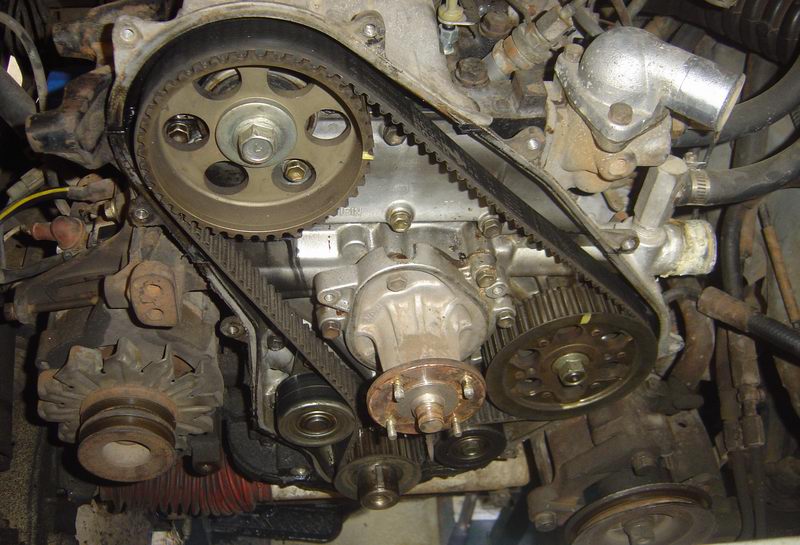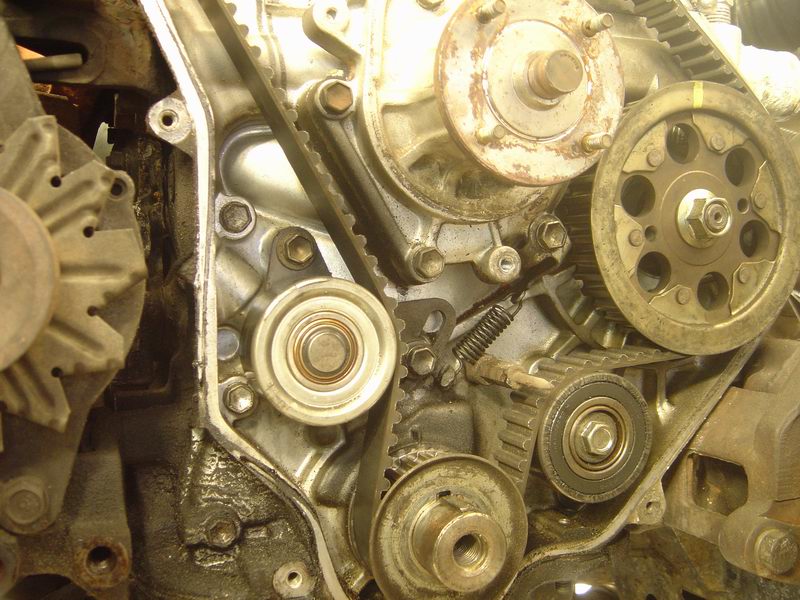I'd changed the timing belt shortly after buying the car, but that was a long time ago...
Now those familiar with Hiluxes will know the "Timing Belt" indicator on the dash. Contrary to what you might believe this does not mean that the timing belt is functioning correctly, it means it is time to change the belt. No sensors or switches here - the light is triggered by the x00,000 digit on the odometer; ie, every time you clock up another 100,000km the light comes on and you should change the timing belt.
Now let me tell you a little secret...yes, you can reset the warning light and once I tell you how you are going to whack yourself in the forehead and say "I can't believe I didn't work that out myself!" like I did.
On the dash you have a button to reset the trip meter, on the otherside of the speedo there is like a blanked off type of thing. Never really thought about it? Well you can push a skinny screwdriver or piece of wire through the rubber and on the dash is a little tiny switch. Push that switch - once only - to reset the T-belt light. If you push it twice the light comes back on. Pretty much all old diesel cars have this feature. It took me years of driving with the T-belt light on before someone told me this, and I had asked around/surfed the internet. Now you know!

Timing belt arrangement - cam top,
injector pump on right, crank down bottom.
Couple of idler pulleys to hold tension.
Anyway, rip out the radiator. Much easier access once it is out of the way. Note that if you unbolt the fan and let it sit in the shroud you won't have to remove the shroud. Use a puller on the harmonic balancer. Hmm, I should have taken a photo for you. Any decent car shop will sell you a universal puller for about $20. Basically you screw two bolts into the front of the balancer (there are factory holes put there especially for it); the puller has a big centre screw, turn it in and the harmonic balancer comes off. Very easy. Don't use two big screwdrivers, it's not worth it!
Next whip all the screws out holding the plastic cover on and reveal the timing arrangement. Camshaft on the top, fuel injector pump on the right, crank down the bottom. An idler pulley bottom right, a tensioning idler pulley bottom left, running on the back of the belt to create tension. Apparently there are two types - a 25mm 130 tooth belt like this on here, and a 20mm 131 toothed belt. You can't tell the difference until you've looked at it; don't get it wrong...
Rotate the crank (screw the harmonic balancer nut back on, use a ratchet to turn) until the cam timing mark (yellowed in the photo) is at 3 o'clock. Back off the tensioner bolts a bit and the belt will come off.
The three biggies - the cam, the pump (both same pulley size) and the crank (exactly half the number of teeth) must be aligned correctly, relative to each other, in order for the engine to run properly. As in, open valves, squirt in diesel, suck in air, etc etc. You can see on the photo the timing marks - cam mark should line up at 3 o'clock, pump at 12 o'clock and the crank also at 12 o'clock.
Although the injector pump won't want to stay at 12 o'clock when you are trying to line it up, it isn't too hard to get the timing right. Once the belt is on, let the tensioner take up most of the slack and tighten the bolts. Rotate the crank through 2 revolutions to get back to where you started, and ensure that the timing points still line up. It is pretty obvious if you have one a tooth out and trust me you don't want to be a tooth out.
Once you are satisfied, set the tension. It's a bit of a strange system: first slacken off the tensioner bolts. The spring on the tensioner will now pull the belts in. Wobble the belt around a bit until the tensioner has pulled the belt in as far as it can. Now bolt the tensioner down solid - ie, tension is set permanently. The 100,000km timing belt I replaced was pretty stretched and loose so I can see why they say change every 100,000km.
Oh and while you have the belt off, grab the idler pulleys for a wobble and see if you can get any movement out of their bearings. If you can feel excessive movement, or they spin a bit grindy, replace them. I replaced both the tensioner and the idler pulley, bit gritty for my liking, $50 each. They are bought as a single unit so no, you don't have to dismantle them and replace the bearings separately.
Should be good for another 100,000km now :)










 database
database